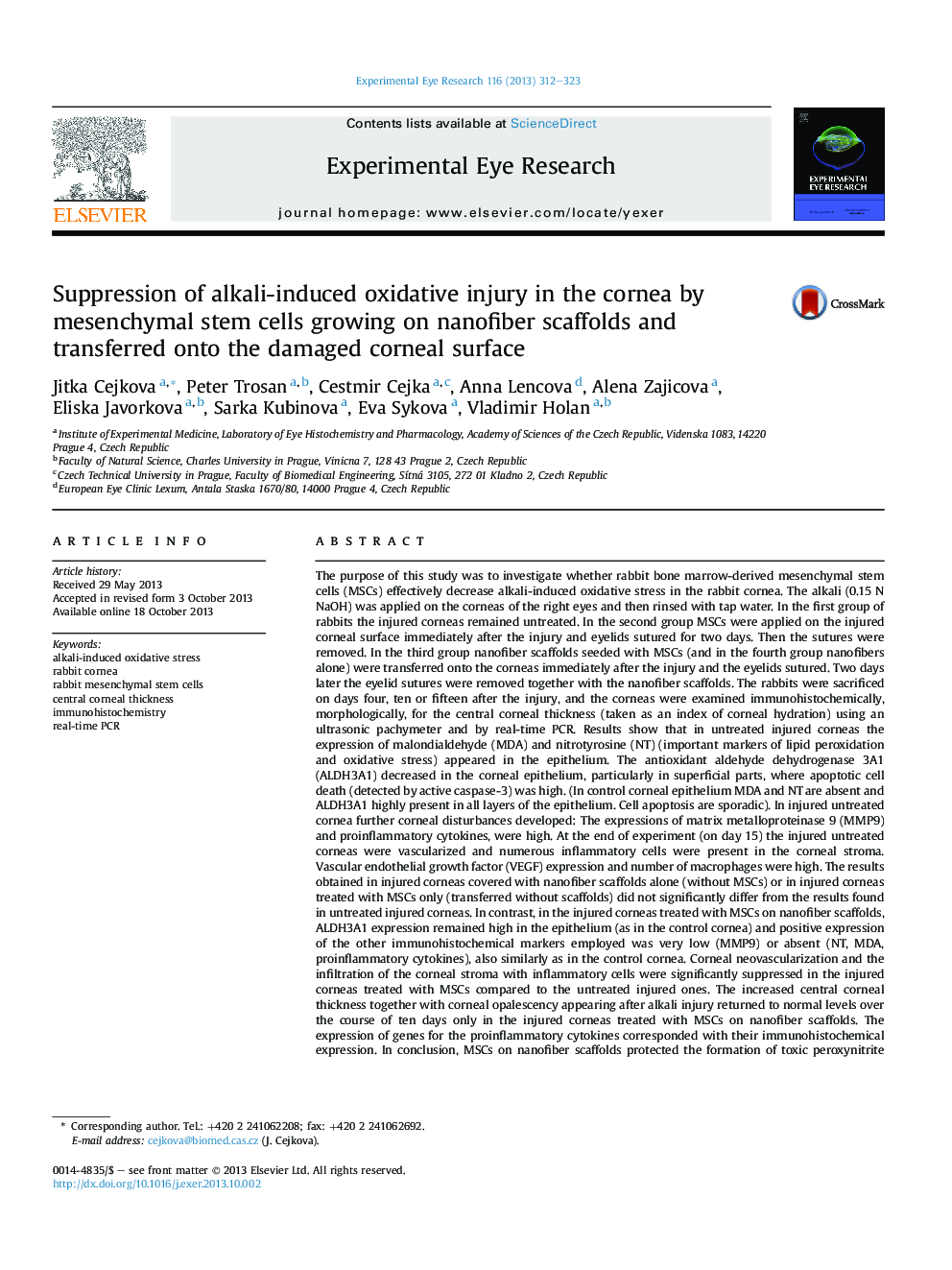| کد مقاله | کد نشریه | سال انتشار | مقاله انگلیسی | نسخه تمام متن |
|---|---|---|---|---|
| 6197218 | 1602606 | 2013 | 12 صفحه PDF | دانلود رایگان |
- The cornea injured by alkali-induced oxidative stress threatens the vision.
- Damaged cornea is treated with mesenchymal stem cells (MSCs) on nanofiber scaffolds.
- MSCs protect the decrease in antioxidants and peroxynitrite formation in the cornea.
- MSCs reduce metalloproteinase and pro-inflammatory cytokine induction in the cornea.
- MSCs suppress corneal inflammation, neovascularization and accelerate healing.
The purpose of this study was to investigate whether rabbit bone marrow-derived mesenchymal stem cells (MSCs) effectively decrease alkali-induced oxidative stress in the rabbit cornea. The alkali (0.15Â N NaOH) was applied on the corneas of the right eyes and then rinsed with tap water. In the first group of rabbits the injured corneas remained untreated. In the second group MSCs were applied on the injured corneal surface immediately after the injury and eyelids sutured for two days. Then the sutures were removed. In the third group nanofiber scaffolds seeded with MSCs (and in the fourth group nanofibers alone) were transferred onto the corneas immediately after the injury and the eyelids sutured. Two days later the eyelid sutures were removed together with the nanofiber scaffolds. The rabbits were sacrificed on days four, ten or fifteen after the injury, and the corneas were examined immunohistochemically, morphologically, for the central corneal thickness (taken as an index of corneal hydration) using an ultrasonic pachymeter and by real-time PCR. Results show that in untreated injured corneas the expression of malondialdehyde (MDA) and nitrotyrosine (NT) (important markers of lipid peroxidation and oxidative stress) appeared in the epithelium. The antioxidant aldehyde dehydrogenase 3A1 (ALDH3A1) decreased in the corneal epithelium, particularly in superficial parts, where apoptotic cell death (detected by active caspase-3) was high. (In control corneal epithelium MDA and NT are absent and ALDH3A1 highly present in all layers of the epithelium. Cell apoptosis are sporadic). In injured untreated cornea further corneal disturbances developed: The expressions of matrix metalloproteinase 9 (MMP9) and proinflammatory cytokines, were high. At the end of experiment (on day 15) the injured untreated corneas were vascularized and numerous inflammatory cells were present in the corneal stroma. Vascular endothelial growth factor (VEGF) expression and number of macrophages were high. The results obtained in injured corneas covered with nanofiber scaffolds alone (without MSCs) or in injured corneas treated with MSCs only (transferred without scaffolds) did not significantly differ from the results found in untreated injured corneas. In contrast, in the injured corneas treated with MSCs on nanofiber scaffolds, ALDH3A1 expression remained high in the epithelium (as in the control cornea) and positive expression of the other immunohistochemical markers employed was very low (MMP9) or absent (NT, MDA, proinflammatory cytokines), also similarly as in the control cornea. Corneal neovascularization and the infiltration of the corneal stroma with inflammatory cells were significantly suppressed in the injured corneas treated with MSCs compared to the untreated injured ones. The increased central corneal thickness together with corneal opalescency appearing after alkali injury returned to normal levels over the course of ten days only in the injured corneas treated with MSCs on nanofiber scaffolds. The expression of genes for the proinflammatory cytokines corresponded with their immunohistochemical expression. In conclusion, MSCs on nanofiber scaffolds protected the formation of toxic peroxynitrite (detected by NT residues), lowered apoptotic cell death and decreased matrix metalloproteinase and pro-inflammatory cytokine production. This resulted in reduced corneal inflammation as well as neovascularization and significantly accelerated corneal healing.
147
Journal: Experimental Eye Research - Volume 116, November 2013, Pages 312-323
